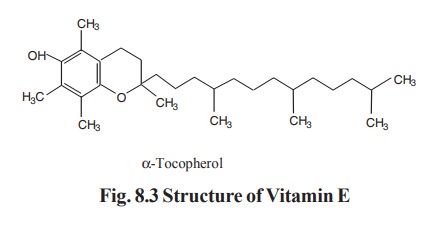Chapter: Biochemistry: Vitamins
Vitamin E
Vitamin E
Vitamin E activity is possessed by a number of
compounds known as tocopherols. Among these compounds α-tocopherol is known as
vitamin E. Structurally vitamin E contains a dihydro benzopyran nucleus with an
isoprenoid side chain (Fig. 8.3). Many of them are pale yellow oils soluble in
fat.

Functions
The principal role of vitamin E appears to be
as an antioxidant. By accepting oxygen, vitamin E can prevent the oxidation of
vitamin A in the intestinal tract, thus making vitamin A available for body
use. Vitamin E also reduces the oxidation of the poly unsaturated fatty acids,
thereby helping to maintain normal cell membrane. It protects the red blood
cells against hemolysis. Vitamin E is required by animals, and presumably, by
humans for the normal reproductive processes. It also plays an important
protective role during ageing of cells.
Sources
Wheat germ oil and corn germ oil are the rich
natural sources. Vegetable oils and fats are good sources. Cereals and animal
foods are fair sources of tocopherol.
Requirements
It is difficult to establish vitamin E
requirements. The requirement depends mainly on the intake of poly unsaturated
fatty acids. It is generally accepted that the intake of vitamin E should be
0.4 mg α -tocopherol equivalents / g dietary poly unsaturated fatty acid. This
does not present any problem, since all foods which are rich sources of poly
unsaturated fatty acids are also rich sources of vitamin E.
There is some evidence that higher intake of
vitamin E may have a useful protective effect against the development of
ischaemic heart disease. This is because high concentrations of vitamin E
inhibit the oxidation of poly unsaturated fatty acids in plasma lipoproteins
and this oxidation which is responsible for the initiation of atherosclerosis
(deposition of fat in the coronory artery walls). The levels that appear to be
beneficial are of the order of 17-40 mg α -tocopherol/day, which is above what
could be achieved by eating ordinary foods.
Adults : 25 - 30 mg / day
Absorption and storage
Vitamin E, like other fat soluble vitamins, is
absorbed along with fat in the intestines.
It is stored in the liver, muscle and body fat.
Deficiency
Vitamin E deficiency cause the following
disorders in animals.
Reproductive failure
Hemolysis of red blood cells
Muscular dystrophy
Related Topics